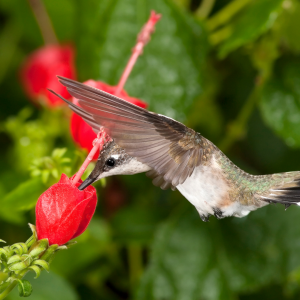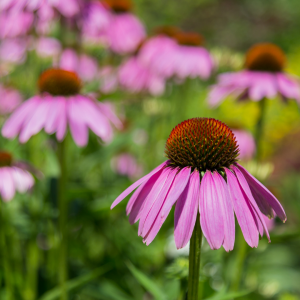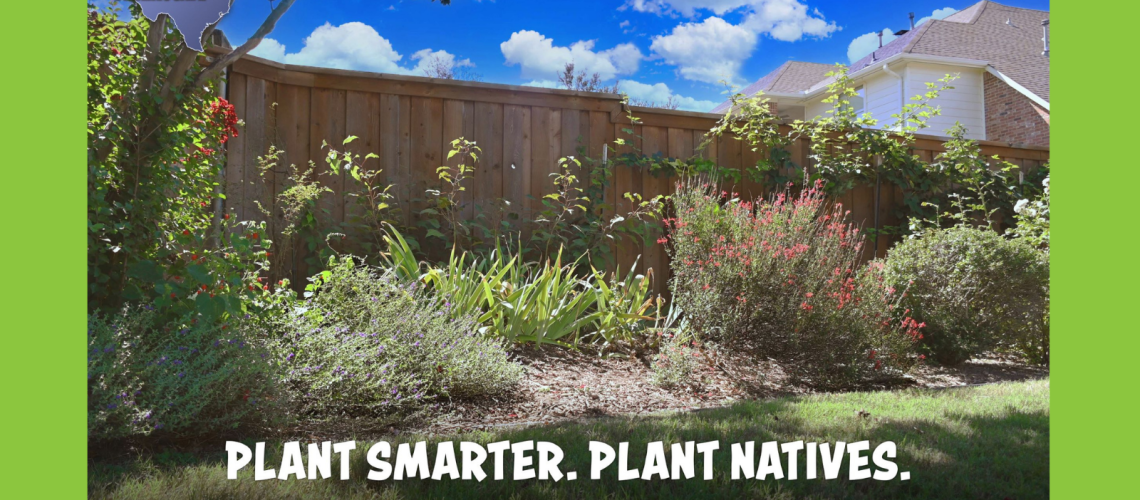It’s almost time to roll up our sleeves, pull out the garden gloves and begin preparing flower beds for spring spruce ups and planting! This year as you are considering what you’d like to plant and where to place it, take a look at the Texas SmartScape™ website for some plant and landscape design inspiration. The Texas SmartScape™ program has carefully curated a database of perennials, shrubs, grasses, vines, groundcover, and trees that are either native or highly adaptive to the North Central Texas region. This means that you can trust that these choices will not only survive our specific climate and soil challenges, but they will also look attractive to boot! Once established, these plants will not only require less water and fertilizer but, they will also provide important habitats for wildlife and pollinators to live in. Try looking up some of the plants featured in our Plant Smarter. Plant Natives. ad this year – Turks Cap, Flame Acanthus, and Shrubby Skullcap – to see how they may fit the light requirements, landscape use, and wildlife value specific to your landscaping.

The Texas SmartScape™ program’s website, www.txsmartscape.com, is a great source for ideas, resources, and tools for a successful growing season. Visit the Plant Search page to access the plant database where you can filter by plant type, light requirement, plant form, water demand, plant height, plant spread and more. The database even has an option to filter by wildlife value so you are certain to find plants that will attract birds, bees, and butterflies to your yard. Want to avoid attracting wildlife such as deer? We’ve covered that too under the landscape uses filter. Looking for even more design inspiration or a creative way to build your plant wish list? Check out our Pinterest boards and start Pinning your ideal landscape today.

By using Texas SmartScape™ plants to invest in a more resilient and wildlife friendly landscape, we can preserve the quality of the ecosystems around us and secure our future water supplies. SmartScape™ approved plants minimize, or eliminate, the use of fertilizers and pesticides which is beneficial to our waterways and local wildlife. Stormwater and irrigation runoff can carry chemicals from residential yards into your neighborhood creeks, streams, ponds, lakes, and rivers.
Want to spruce up your yard, reduce the use of pesticides and fertilizers, and save water?
- Use native and adapted plants. Texas SmartScape™ plants can thrive in the wide range of temperature and moisture conditions typical in North Texas. These hardy plants are rarely plagued by major pest problems, thus reducing or even eliminating the need for pesticides. They are also capable of maintaining healthy, vigorous growth in our region’s soils without the use of much—or any—fertilizer. (Although they might appreciate a nutrient boost once a year or so.) Once native and adapted plants are established, they require much less water than other plants.
The Texas SmartScape plant search tool allows you to find SmartScape-approved plants that are the right fit for your yard. You can search by 13 different parameters, including plant type, plant shape and size, light requirement, ornamental color, wildlife value, bloom season, landscape use, and more.
- Reduce turf grass. Lawns typically require a large amount of supplemental water and more intensive maintenance than other vegetation. You can use the SmartScape design page and SmartScape Pinterest boards to develop ideas to transform your lawn into a resilient and attractive landscape.
- Use organic mulch and compost. Mulch reduces water loss from the soil, represses weeds, moderates soil temperature, and helps prevent soil erosion. Compost also retains moisture in the soil and provides valuable nutrients to your plants.
- Water efficiently and effectively, no more than twice per week. Up to 50 percent of irrigation goes to waste due to evaporation, wind, improper system design, leaks, or overwatering. Here are some tips to help you water more efficiently.
- Sign Up for free Weekly Watering Advice. Get free watering advice custom to your location’s conditions every Monday. Sign up at WaterIsAwesome.com.
- Get a free Sprinkler Evaluation. Tarrant County residents can sign up for a free residential sprinkler system evaluation from a licensed irrigator.
- Water early or late in the day. To avoid water loss from evaporation, water your yard between 8 p.m. and 10 a.m. (Early morning is best.)
- Water deeply and infrequently. One method of watering deeply and efficiently is called “cycle and soak.”
- Use irrigation systems wisely. If you have an irrigation system, consider using a smart irrigation control system or manually set the controller on an as-needed basis.
- Install drip irrigation in flower beds and at the roots of shrubs. Almost 95 percent of drip irrigation water can reach a plant, while traditional automatic sprinklers are much less efficient.

Texas SmartScape™ Program
The Texas SmartScape™ program was developed in 2001 with support from the North Central Texas Council of Governments, its member governments (including several of the region’s water providers), Texas A&M AgriLife Extension, Texas Parks & Wildlife, and Weston Gardens. It is currently supported by the North Central Texas Council of Government’s Regional Stormwater Management Program.
Texas SmartScape™ is a landscape program that promotes the use of plants suited to the North Central Texas soil, climate, and precipitation. The regional goals are:
- to improve water quality by reducing runoff, and
- to conserve local water supplies by selecting ecologically appropriate native or adapted plants that require less water, pesticides, fertilizers, and herbicides.
For more information, visit www.txsmartscape.com.


